 |
THE NATIONAL LIBRARY
The Vallianios National Library
The National Library forms part of the so-called "Neoclassical Trilogy" of the City of Athens: Academy - University - Library. It consists of three solid parts, out of which the one in the middle -which is also the biggest- houses the Reading-Room. To enter this part, one has to pass through a Doric-style row of columns (designed |
|
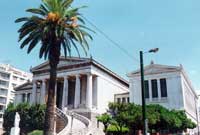 |
|
| after the Temple of Hephaestus in the Ancient Agora of Thission, which served as its model), after climbing on a monumental curved double staircase of a Renascence style. The Reading-Room, surrounded by Ionian-style columns, is covered by a glass ceiling. The cast-iron constructions of the bookstands were referred to as exceptional back in their time. In general, the building is considered to be a characteristic sample of mature Neoclassicism. |
|
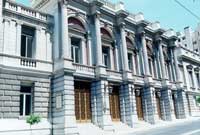 |
|
THE NATIONAL THEATER
Hadrian's Library in Athens served as a model for the structure of the monument's facade which consists of a central part immensely enriched by decorative elements, a Corinthian-style column row and two lateral parts of a typical neo-classical composition. The influence from Renascence buildings is more than evident. |
|
THE OLD PARLIAMENT BUILDING
The Old Parliament Building is located on Stadiou Street, in the square where the statue of Theodoros Kolokotronis, Commander-in-Chief of the Revolution of 1821, is also situated. The building is an architectural jewel in the
center of Athens and one of the most historic buildings of the city. |
|
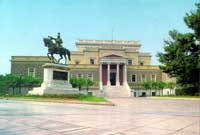 |
|
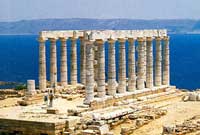 |
|
SANCTUARY OF POSEIDON AND ATHENA AT SOUNION
The sanctuary at Sounion is one of the most important sanctuaries in Attica. Sporadic finds point to the conclusion that the site was inhabited in the prehistoric period but there is no evidence of religious practice in such an early date. "Sounion Hiron" (sanctuary of |
|
| Sounion) is first mentioned in the Odyssey, as the place where Menelaos stopped during his return from Troy to bury his helmsman, Phrontes Onetorides. The finds of the 7th century B.C. are numerous and prove the existence of organized cult on two points of the promontory: at the southern edge where the temenos of Poseidon was situated, and about 500 m. to the NE of it, where the sanctuary of Athena was established.
|
|
NAUTICAL MUSEUM OF GREECE
The Museum was founded in 1949 and comprises nine rooms, where the nautical history of Greece, from prehistoric times to our day, comes to life. Among the exhibits there are models of ancient and
modern ships, paintings by some of the greatest 19th and 20th century Greek painters of seascapes (Prossalendis, Volanakis, Hadjis, etc.); also guns, maps, flags, medals, nautical |
|
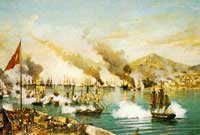 |
|
| instruments, etc. There is also a specialized library in the Museum with 10,000 volumes and rich archival material, a photographic and film collection, which includes, among others, the archives of Admiral Kriezis and approximately 200 maps (16th -20th centuries).
|
|
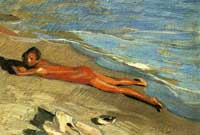 |
|
MUNICIPAL GALLERY OF PIRAEUS
The Municipal Gallery of Piraeus was inaugurated in 1957 and began to function as a section of the Municipal Library in the building of the Municipal Theatre. In 1985 it became an independent department and included 837 works, among which works by M. Axelos, K. Volanakis, P. Vyzantiou, A. Geralis, E. Doukas, D. Kokotsis, Th. |
|
| Lazaris, N. Lytras, K. Maleas, M. Ekonomou, K. Romanides, A. Christofis, as well as works by many notable younger artists, among whom a special place is reserved for a considerable number of artists from
Piraeus. Also in the Municipal Gallery is the collection of 80 sculptures by George Kastriotis, a collection of 156 works by the popular artist St. Lazaros, as well as the collection donated by the famous Greek actor Manos Katrakis (theatrical costumes, photographs and theatrical material, personal belongings, etc.).
|
|
FRISSIRAS MUSEUM
The Frissiras Museum, the only Museum for Contemporary European Painting in Greece, was inaugurated on November 27, 2000 by the President of the Republic Constantine Stefanopoulos and officially opened on December 4, 2000. It is housed in
Plaka, in two adjacent neoclassical buildings brought up to the latest museum specifications, and operates as a nonprofit private entity. |
|
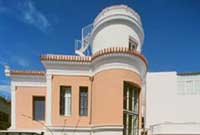 |
|
| The collections comprise sections of paintings, drawings, sculptures and engravings by major European artists in constructive dialogue with their Greek counterparts, and attempt to trace the trends and record the figures of the anthropocentric European painting after World War II.
Among the exhibits of the Museum are works by Hockney, Auerbach, Blake, Rustin, Pat Andrea, Dado, Segui, Rego, Velickovic, Arroyo, Adami, Diamantopoulos, Moralis, Μavroidis, Theofylaktopoulos, Botsoglou, Dikos Vyzantios, Christoforou and the younger Kirby,
Howson, Corpet, Martinelli, Smith, Pasieka, Marrey, Schauwecker, Lappas, Missouras, Manzavinos, Sacaillian, Daskaliakis, Bitsikas... It is noted that the collection comprises over 3000 works.
The Museum has already formed cooperation schemes with other European institutions (Veranneman Museum, Whitechapel, Adami Foundation, Maeght Foundation, Onassis Foundation) for the exchange of exhibitions and related activities. The operation of the Museum is based entirely on private initiative and aims to promote contemporary Greek art internationally and serve as a forum for the acquaintance with European art.
The Frissiras Museum has already scheduled for the 2001-2004 period a series of individual retrospectives for artists works of whom are held in its collections. As part of this program the exhibition was held of Dutch painter Pat Andrea (April 6 - June 16, 2001), to be followed by major retrospectives for the important French painter Vincent Corpet (September 27 - November 25, 2001) and the established Greek artist Costas Tsoclis (November 29, 2001 - January 27, 2002).
At the same time the Frissiras Museum organizes guided tours and educational programs and hosts various cultural activities and concerts, at the atrium in Building 3 and the open-air auditorium of Building 7. Visitors to the Museum can avail themselves of the Cafe and the Art Shop, which proposes original art objects, decorative or functional. |
|
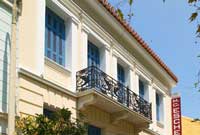 |
|
HERAKLEIDON
A new private museum space in the heart of Athens, under the shadow of the Acropolis, has opened its doors to friends of the fine arts. The exhibition program will consist of artists who play or have played an important role in the evolution of Art.
The museum's mission is to initiate visitors into the art of the exhibited artist; to show how the artist has evolved through the various periods |
|
| in his or her creative work, to explain the various techniques used by the artist to express his or her vision, and to help the visitors connect to both the artist's life and work.
To this aim, not only will works of the artist be on exhibit, but also preparatory sketches, drawings, photographs and personal items. Audiovisual and other aids will provide complete and detailed information on the life of the artist, each phase of his or her work, and the technique or techniques used.
In addition to the permanent collections, the museum "Herakleidon, Experience in Visual Arts" will host temporary exhibitions of work by Greek and foreign artists. The museum will also host other events, such as musical performances, literary events, book presentations, scientific and other seminars, corporate presentations, conferences, and lectures beyond those pertaining to the visual arts.
The Museum "Herakleidon, Experience in Visual Arts" is housed in a building dating back to 1898, a striking example of neoclassical architecture and one of the few remaining in Athens.
Mr. Paul Firos and his wife Anna-Belinda, collectors and art lovers, were inspired to create this new private museum by their love of neoclassic buildings and their intention to preserve such buildings, combined with their desire to share with others their enthusiasm for the fine arts and thus contribute to the artistic life of
Athens.
Although badly damaged by the many earthquakes it had withstood, the neoclassic building at number 16 on Herakleidon Street in the neighborhood of Thissio, was completely restored, renovated and designed according to the highest standards.
In keeping with its function as a museum, the most up-to-date security, protection and display systems have been installed. Lighting with optical fibers, temperature and humidity controls, and proper visitor circulation meet the most exacting museum specifications. |
|
|
 |
|
|
|